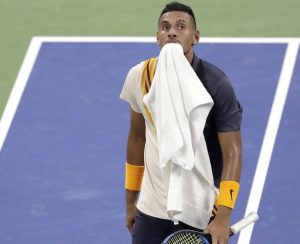
The match between Nick Kyrgios and Roger Federer in the third round of the US Open 2018, was a reminder of why Kyrgios has never won anything significant. He plays his best tennis, when he doesn’t think that much, is relaxed and is mixing it up with trick shots, drop shots, heavy spins, flat shots and so on. But when things get tough, and to quote Eminem: »His palms are sweaty, knees weak, arms are heavy.«, everything falls apart. And I’m not even talking about his mentality. I’m not trying to defend Nick, but I believe that his mentality on the court is mostly because he can’t play great tennis when he is being too serious and is focusing too much on the tennis. I know it sounds counter-intuitive to any serious tennis player, but bear with me I’ll try to explain using some of the core principles introduced on this site. It’s his low swingweight, head light balance and relatively low mass. In fact, Kyrgios has got the lowest swing weight among the professional players that I know of. Let’s take a look at what low or high swingweight translates to as described in the swingweight chapter:
»High swingweight also means you need longer strokes to accelerate the racquet. Think about Rafael Nadal and Alexander Zverev (Novak Djokovic is also here but not so extreme). They both have hight swing weight and low MGR/I, and they have long strokes, especially on the forehand side, and they play with incredible control and consistency. On the other side of the spectrum is, for example, Nick Kyrgios. Low swingweight, hight MGR/I, short strokes, incredible racquet head acceleration but a lack of consistency, because when he get’s tight, the slightest deviations in his stroke mechanics cause a much bigger change in the racquet head position at contact. On the other hand, Nadal and Zverev when they get tight their only job is to get the racket through the contact and the ball goes in. They spend much more energy doing that, but they can go in the »lockdown« mode and not miss.«
To recap, the biggest problem is the lack of effective mass (swingweight) on collision with the ball. To get comparable amounts of spin and power with his racket, to someone with a higher swingweight, he needs very high swing speeds. To understand this, check the momentum equations in the chapter mass and balance. High swing speeds translate to less margin for error because the timing has to be perfect on every shot. His backhand is also unorthodox because of this. He accelerates it very quickly with not a lot of backswing.
Of course, the low swingweight and very headlight balance also have their advantages, like for example, the racket is very maneuvrable, enabling Nick to hit all those trick shots, tweeners and so on. For this reason, I also don’t see Nick as particularly talented as the racket enables him to do the things he does. But unfortunately, the racket also hinders his ability to play consistent tennis from the baseline when he needs to. To stay in a long baseline exchange, he needs a much faster swing speed than his opponent with a higher swingweight. He plays his best tennis, when he doesn’t think that much, is relaxed and is mixing it up with trick shots, drop shots, heavy spins, flat shots and so on. But when things get tough, and to quote Eminem: »His palms are sweaty, knees weak, arms are heavy.«, everything falls apart, and Nicks tantrums on the court are his attempts to stay relaxed and play well. But in contrast, someone like Nadal uses hight swingweight as his best friend in tough moments.
In the chapter MGR/I, I also compared Kyrgios and Federer, in terms of MGR/I value and the way their rackets play. But similar MGR/I values just mean that the weight distribution is similar, but not the actual weight and swingweight. Federer is an example of the best of both worlds. He is playing with a high MGR/I and quite hight (not super high) swingweight. But let’s not make this article about Federer.
For now, I will conclude that Kyrgios might snatch a big win here and there, but to expect him to do it for 2 weeks in a grand slam, is a bit unrealistic. He might, if he increases his swingweight, but that would completely change his game-style, and I don’t think that would be good either. In this article, my main intention was to break down some misconceptions about Nick Kyrgios and his game and I hope you can see him in a different light now. I don’t necessarily think he should change anything, but a coach or him understanding these principles could help him make a game plan. For Example, don’t get involved in “baseline bashing” with Federer like he did too often today.
Good information.
Thank you!